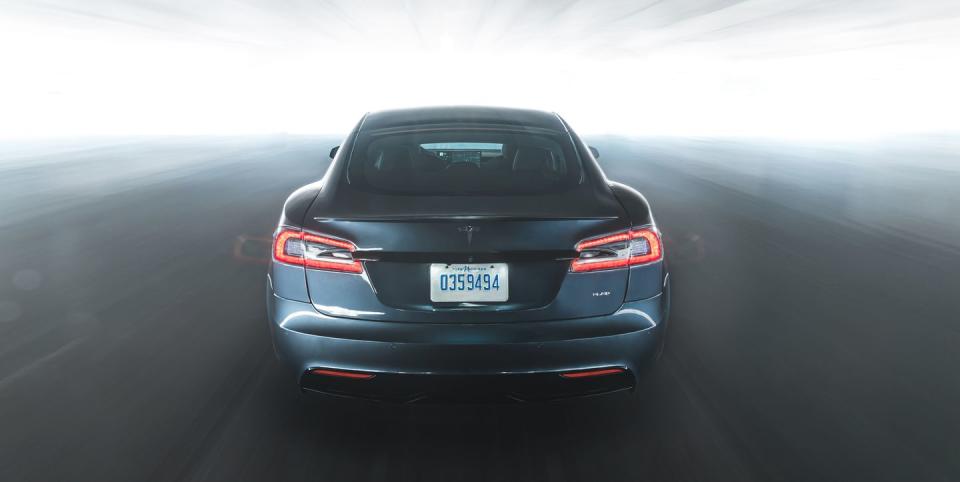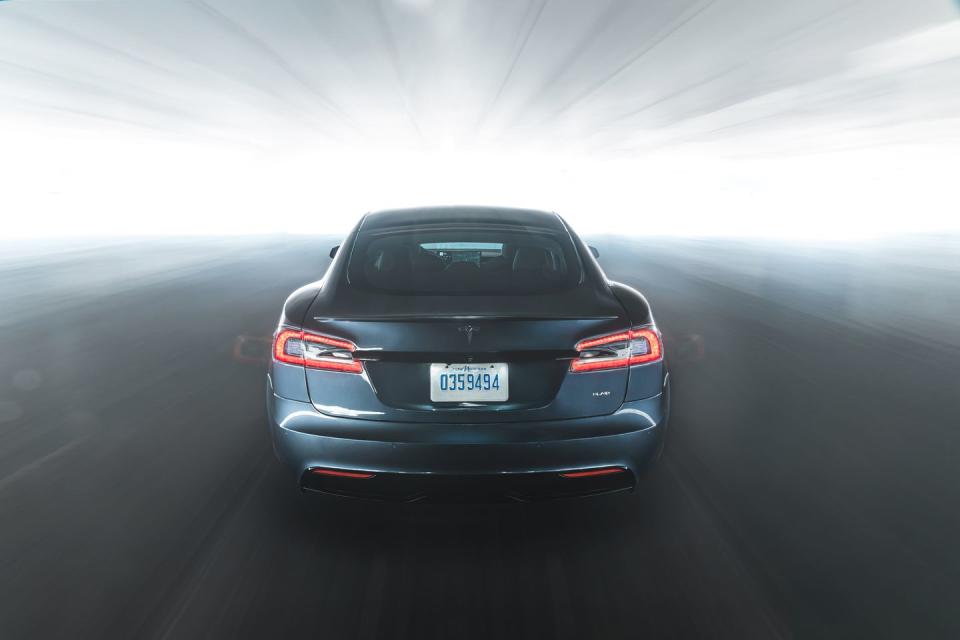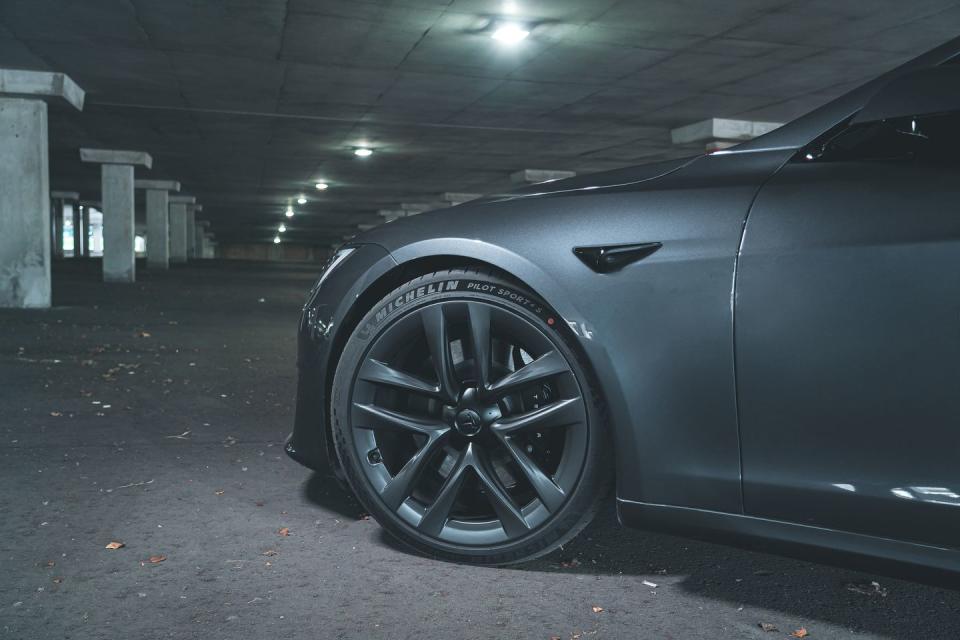Tested: 2021 Tesla Model S Plaid Is Absurdly Quick but Also Has a Few Key Flaws


From the January 2022 issue of Car and Driver.
"Basically, our product plan is stolen from Spaceballs," Tesla CEO Elon Musk said with a smirk when unveiling the 1020-hp Model S Plaid, referring to the 1987 film parody of Star Wars. In that movie, the fastest faster-than-light speed is called ludicrous speed. When the ship Spaceball I reaches that speed, it appears plaid, leading a character to remark in wide-eyed awe, "They've gone to plaid." Both Ludicrous and Plaid have been names for modes in the swiftest Model S variants.
Teslas have always been quick, and the company, led by its nerd-in-chief, seems almost equally proficient at pushing inside-joke boundaries and making serious, industry-shifting moves. The Plaid is the result of both, and it absolutely delivers on taking Tesla's performance to new ridiculous heights. It's the first Tesla powered by three electric motors, two at the rear and a third at the front axle, all of them now permanent-magnet synchronous AC machines. New in the Plaid are carbon-fiber-sleeved rotors (just like it sounds, that's the spinning part of the motor). The carbon-fiber shell holds each rotor together to enable rotational speeds of up to 20,000 rpm, about 25 percent faster than before. Because of the dissimilar coefficients of thermal expansion between carbon and copper, Tesla says the motor's copper wire must be wound at extremely high tension, resulting in a very efficient electromagnetic field. Furthermore, the Plaid addresses the EV shortcoming (particularly in those that employ a direct-drive transmission, like Teslas) that power falls off dramatically with speed. Tesla claims that the Plaid continues to make 1000 of its 1020 horsepower all the way to its 200-mph top speed. Despite the extra motor, the Plaid weighed in at 4828 pounds, 175 pounds lighter than the last Model S Performance we tested.

To unlock maximum acceleration, select Drag Strip mode, which heats the battery to the optimum temperature, then mash and hold the brake and accelerator pedals for about 10 seconds to signal the air springs to lower the front end. The front tires tuck into the fenders in what Tesla calls a cheetah stance (without the waiting, we found it to be just 0.1 second slower to 60 mph and through the quarter-mile). The initial launch hit isn't the gut punch you might expect, as the power must be ramped in judiciously to maintain traction. The shocking bit is after the Plaid's 2.1-second flash to 60 mph, when it's accelerating so quickly that your surroundings start to mimic the silly plaid animation on the dash screen. The VBox test equipment recorded 4.3 seconds to 100 mph and a 9.4-second quarter-mile, a tie with the Bugatti Chiron Sport for the quickest quarter we've ever measured.
If you've been following Tesla, you know that performance tapers off quickly after more than one or two acceleration runs on a full charge. No longer. The Plaid's radiator is twice as large as before, and our test car ran eight consecutive consistent passes, the last one at an 80 percent state of charge.

The Plaid is certainly the least ostentatious car that can run nines in the quarter-mile. It doesn't draw envious looks or adulation on the road. All its new tricks are hidden beneath familiar, decade-old sheetmetal. But for a large four-door that seats five, rides comfortably, and starts at $131,440 to mix it up with multimillion-dollar exotics is an amazing accomplishment. The Plaid actually blows the quickest exotics away in our passing tests, where it shot from 30 to 50 mph in 0.9 second and from 50 to 70 mph in 1.0 flat. Those are the quickest times our test gear has ever witnessed, more than twice as quick as the Chiron and about a 30 percent improvement over last year's Model S Performance and the Porsche Taycan Turbo S.
But it wouldn't be Tesla if it didn't overpromise, and the Plaid can't get anywhere near the company's 200-mph claims. Our test car topped out at a governed 162 mph, no faster than last year's Model S Performance. Tesla is perpetually a few software releases—and new vehicles and assembly plants—away from delivering on its claims, and it of course swears that an update will unlock the true Plaid speed.

But, trust us, you don't want to do 200 mph in this car. Even 162 mph was terrifying, wandering and nervous to the point that we were concerned about our ability to shepherd it between lane lines. The steering doesn't firm up enough with speed, making the task more difficult. At similar velocities, a Taycan is resolutely stable. Another reason to fear a 200-mph speed is brakes that got soft during our testing. Although our braking regimen isn't nearly as severe as what a racetrack demands, a warning message reporting the brakes' demise popped up on the dash. Between the flappability at high speeds and the iffy brakes, our helmets are way off to former FIA GT racing driver Andreas Simonsen, who piloted the Plaid to what must have been a harrowing 7:35 Nürburgring lap.
The Plaid's huge improvement in cornering grip likely played a part in that 'Ring time. On the skidpad, the Tesla delivered a Corvette-beating 1.08 g's, up from 0.92 g. The Plaid-spec Michelin Pilot 4S tires are 30 millimeters wider than before with perhaps some Cup 2 magic sprinkled in.

Now it's time for your regular reminder that there's more to the driving experience than numbers, a drum we beat regularly when we explain why a clear objective champ didn't win a comparison test. The Plaid is a zombie at the limit, with nothing coming up through the two girthy grips at the end of the steering yoke. Getting that staggering skidpad number took far more runs than is typical because of the car's unpredictability. Turning right, it would walk itself into oversteer, which would then result in a heavy-handed smackdown from the stability control. Tesla touts that the Plaid's dual rear motors enable torque vectoring, but there's none to be had near the limit because of the undefeatable safety net. A Model 3 Performance with the variable (and defeatable) Track-mode settings is far more satisfying and fun.

 Yahoo Autos
Yahoo Autos 